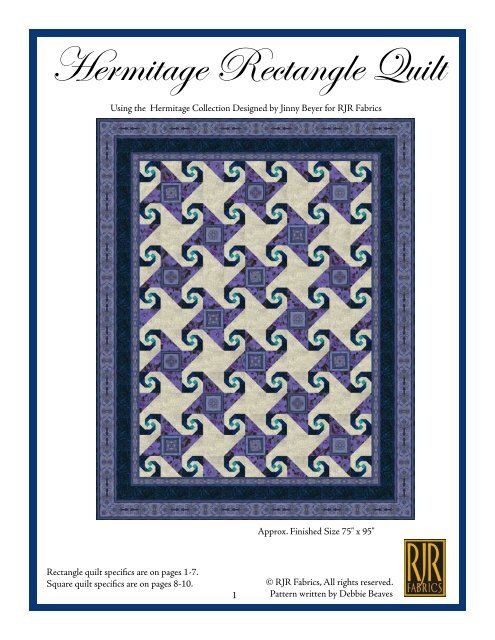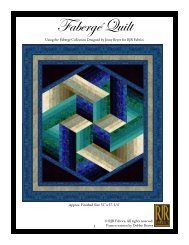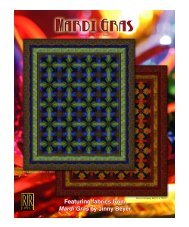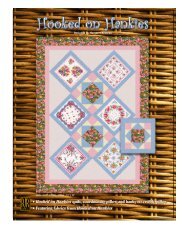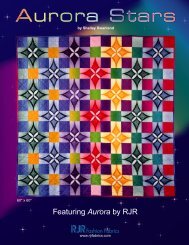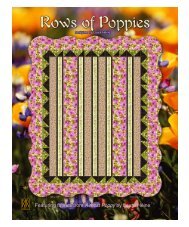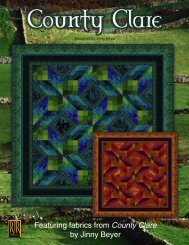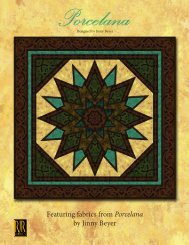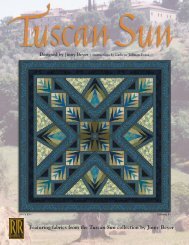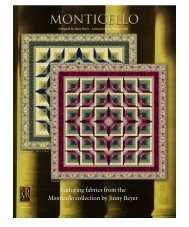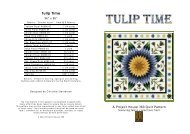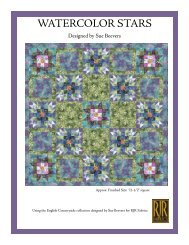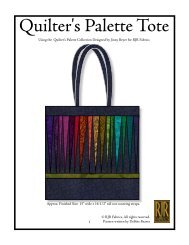Download PDF - Jinny Beyer Studio
Download PDF - Jinny Beyer Studio
Download PDF - Jinny Beyer Studio
You also want an ePaper? Increase the reach of your titles
YUMPU automatically turns print PDFs into web optimized ePapers that Google loves.
Hermitage Rectangle Quilt<br />
Using the Hermitage Collection Designed by <strong>Jinny</strong> <strong>Beyer</strong> for RJR Fabrics<br />
Approx. Finished Size 75" x 95"<br />
Rectangle quilt specifics are on pages 1-7.<br />
Square quilt specifics are on pages 8-10.<br />
© RJR Fabrics, All rights reserved.<br />
1 Pattern written by Debbie Beaves
INSTRUCTIONS~ Read entire pattern before<br />
beginning. Use 1/4" seam allowances unless stated<br />
otherwise. NOTE: A1 = Cut A from fabric 1<br />
1.<br />
2.<br />
3.<br />
Sew the A1 and A2 strips into four sets (3 WOF<br />
and 1 18" length). Press the seam allowance in the<br />
direction indicated by the arrow. Cut the strip sets<br />
into 96 1-3/8" wide units.<br />
Sew the units into four patch blocks. Press.<br />
Sew a B1 triangle to opposite sides of a four patch<br />
block. Be careful the blocks rotation matches the<br />
diagram below! Press and trim excess fabric. Repeat<br />
for a total of 48 blocks. Using the same process sew<br />
B3 triangles to each block. Press and trim.<br />
B1<br />
A1<br />
A2<br />
Cut 96 1-3/8" wide units<br />
+ =<br />
Make 48 four patch blocks<br />
Measure 2-1/4" square<br />
B3<br />
5.<br />
6.<br />
7.<br />
Repeat for D1 and<br />
D5 triangles. The<br />
Snail Trail blocks<br />
are now complete.<br />
There should be a<br />
total of 48 5-1/2"<br />
square blocks.<br />
Sew the F triangles<br />
into HST (half square<br />
triangle) units. Press<br />
and trim.<br />
Sew the G7<br />
triangles into<br />
QST (quarter<br />
square triangle)<br />
units. First into<br />
halves and then<br />
whole units for a<br />
total of 18 5-1/2"<br />
squares. Press to<br />
one side.<br />
D1<br />
D5<br />
Make 48 Snail Trail blocks<br />
Measures 5-1/2" sq.<br />
F1<br />
F6<br />
Make 82 HST units.<br />
Measures 5-1/2"<br />
G7<br />
Make 18 total blocks in at least<br />
4 different motif isolations.<br />
Measures 5-1/2"<br />
Make 48<br />
Make 48<br />
Measures 3" square<br />
Four variations of G blocks<br />
finished size 5" square.<br />
4.<br />
Repeat the process<br />
adding the C1<br />
triangles to the<br />
blcks and then<br />
the C4. Press<br />
and trim after<br />
each addition.<br />
C1<br />
C4<br />
Measures 4" square<br />
2
8.<br />
Sew the blocks and units into rows as shown. Press<br />
seam allowances toward the HST units.<br />
10.<br />
Sew border 1 to the quilt using <strong>Jinny</strong>'s special<br />
technique for adding a border print to a rectangular<br />
quilt (page 4).<br />
9.<br />
Sew row to row. Press toward the G QST unit<br />
rows.<br />
11.<br />
12.<br />
Sew the short border 2 strips to the top<br />
and bottom of the quilt. Sew the<br />
long border 2 strips to the sides.<br />
Press.<br />
Sew the border 3 strips<br />
to the quilt using<br />
<strong>Jinny</strong>'s special<br />
technique<br />
described.<br />
G<br />
Template<br />
Can be cut from 3-1/8" wide<br />
strips carefully stacked in<br />
layers of 4, matching repeats<br />
meticulously!<br />
See <strong>Jinny</strong>'s triangle cutting tips on page 6.<br />
3<br />
3-1/8"
<strong>Jinny</strong>'s Framing a RECTANGLE with a<br />
Border Print Technique<br />
Sew borders 1 and 3 to the quilt using the following<br />
technique. The border 3 is shown in the example.<br />
FINISHING<br />
Layer the backing, wrong side up, batting and pieced<br />
top (right side up) together. Baste the layers. Quilt as<br />
desired. Trim the backing and batting flush with the<br />
outer raw edges of the pieced top.<br />
Step 1. Place a strip of the border print across the<br />
middle of the quilt, centering a motif from the border<br />
at the exact center of the piece as shown in the diagram<br />
below.<br />
Step 2. Use a right angle triangle to mark the miter<br />
along one of the edges, making sure to leave enough<br />
for seam allowance. Carefully pick up the mitered edge<br />
of the border strip and bring it over to the other end<br />
of the border strip at the opposite edge of the quilt,<br />
making sure that the design matches. Cut the second<br />
miter. Using this first mitered piece as<br />
a guide, cut one more identical piece,<br />
making sure that the design on the border<br />
print is exactly the same on the top and<br />
bottom strip.<br />
Step 3. Place one of the cut strips on top<br />
of a length of the border print stripe,<br />
matching the design. Cut one miter to<br />
match the miter on the cut strip. Place<br />
the newly cut strip along the length of<br />
the quilt through the center of the quilt<br />
with the mitered edge at the edge of the<br />
quilt. Bring the strip to the exact center<br />
of the quilt and cut it off 1/4 inch beyond<br />
the center. Using this cut strip as a guide,<br />
cut one more piece identical to it and two<br />
strips that are the exact mirror images of<br />
the first piece.<br />
Step 4. Sew the seams at the middle of<br />
two mirror imaged strips and attach these<br />
borders to the quilt. Sewing the borders<br />
to a rectangular quilt in this manner<br />
assures that the corners will match. There<br />
will be a seam at the center of the long<br />
strips, but the design at that center will<br />
mirror image as well, as shown in below<br />
diagram. For more information and color<br />
diagrams go to www.jinnybeyer.com.<br />
Look under tips then border links.<br />
4
Rectangle Quilt Fabric Cutting Suggestions<br />
For clarity in piecing it is very helpful to mark each fabric and cut with a small paper square showing the<br />
number and “cut” letter for example A1.<br />
Fabrics 1<br />
Fabric 2<br />
D<br />
C<br />
B<br />
A<br />
E<br />
Selvage<br />
F<br />
A<br />
Selvage<br />
Fabric 3<br />
Fabric 4<br />
Fabric 5<br />
Fabric 7<br />
Binding<br />
B<br />
Selvage<br />
C<br />
D<br />
Selvage<br />
Fabric 6<br />
Border 2<br />
Selvage<br />
Fabric 7 border 1<br />
cut example.<br />
Will will not be any<br />
scrap left between<br />
these cuts.<br />
2-1/2" wide<br />
G7 cuts example. Make 72 cuts<br />
for a total of 18 blocks in at<br />
least 4 different motif isolations.<br />
Template on page 3. Example shows<br />
4 different placements. See page 6.<br />
Fabric 7<br />
border 3 cut<br />
example.<br />
5" wide<br />
F<br />
Selvage<br />
5
<strong>Jinny</strong> <strong>Beyer</strong>'s Borders Made Easy: Squares -<br />
Step 1<br />
Divide the square diagonally from corner to corner to create<br />
four triangles. Make a template from one of the triangles from<br />
a see-through template material. Be sure to add a ¼ inch seam<br />
allowance around all sides of the piece.<br />
Step 2<br />
Center the template on one of the motifs in the border print<br />
fabric, making sure that a line from the border print falls just<br />
inside the sewing line on the long side of the triangle template.<br />
This ensures that you will have a nice line or frame around the<br />
outside of the finished square. Mark some portion of the design<br />
directly onto the template to use as a guide for cutting the<br />
remaining pieces. Carefully draw around the template and cut the<br />
piece out.<br />
Diagram 1<br />
Diagram 2<br />
If you want to see what the square will look like before actually<br />
cutting the pieces, position the template onto the fabric, then place<br />
two mirrors on the two short sides of the triangle<br />
so they meet at a right angle. Carefully remove the<br />
mirrors to see what the finished square will look like<br />
Step 3<br />
Cut three more triangles identical to the first, then sew<br />
them together to complete the square.<br />
Diagram 3<br />
Step 4<br />
It is amazing how many different squares you can cut from the<br />
same border strip, by simply placing the template in a slightly<br />
different place on the fabric. The squares shown here are just a few<br />
possibilities from the border print shown here.<br />
http://www.jinnybeyer.com/quilttips<br />
6<br />
Diagram 4
Hermitage Rectangle Quilt Fabric Cutting Directions<br />
Fabric 1 8734-41<br />
2-5/8 yards<br />
Fabric 2 8734-02<br />
1/4 yard<br />
A (3) 1-3/8" x WOF & (1) 1-3/8" x 18"<br />
B (48) 2-1/8" squares, cut once diagonally<br />
C (48) 2-5/8" squares, cut once diagonally<br />
D (48) 3-3/8" squares, cut once diagonally<br />
E (17) 5-1/2" squares<br />
F (41) 5-7/8" squares, cut once diagonally<br />
A (3) 1-3/8" x WOF & (1) 1-3/8" x 18"<br />
Fabric 3 8735-03<br />
1/4 yard<br />
B (48) 2-1/8" squares, cut once diagonally<br />
Fabric 4 8737-03<br />
3/8 yard<br />
C (48) 2-5/8" squares, cut once diagonally<br />
Fabric 5 8735-02<br />
2 yards<br />
Fabric 6 8732-03<br />
1-1/4 yards<br />
D (48) 3-3/8" squares, cut once diagonally<br />
Border 2 (8) 3-3/4" x WOF strips. Sew end to end. Trim<br />
to two 66" and two 86" lengths.<br />
Always verify your quilt size before trimming border lengths.<br />
Binding At least 342" of 2-1/4" wide strips sewn<br />
continuous in length.<br />
F (41) 5-7/8" squares, cut once diagonally<br />
Fabric 7 8731-03<br />
5 yards<br />
WOF = Width of fabric (approx. 40" usable)<br />
Backing Suggestion 6 yards of 8732-03<br />
G (72) Triangles using the template on page 3. Cut in<br />
repeats of 4 see page 6. If stacking 3-1/8" wide stripe and<br />
cutting repeats be very careful to line up the motifs.<br />
Border 1 (2) 2-1-/2" x 59-3/4"<br />
(2) 2-1/2" x 79-3/4"<br />
Border 3 (2) 5" x 75-3/4"<br />
(2) 5" x 95-3/4"<br />
Refer to pages 4-6 before cutting!!!<br />
Always verify your quilt size before trimming border lengths.<br />
Approx. Finished Size 75" x 95"<br />
The binding is sewn to quilt<br />
using a 1/4" seam allowance.<br />
7<br />
© RJR Fabrics, All rights reserved.
Hermitage Square Quilt Fabric Cutting Directions<br />
Fabric 1 8734-41<br />
1-1/8 yards<br />
Fabric 2 8734-02<br />
1/8 yard<br />
Fabric 3 8735-03<br />
1/8 yard<br />
Fabric 4 8737-03<br />
1/4 yard<br />
Fabric 5 8735-02<br />
1-1/4 yards<br />
Fabric 6 8732-03<br />
1/2 yard<br />
Fabric 7 8731-03<br />
3 yards<br />
Backing Suggestion 3-1/2 yards of 8732-03<br />
WOF = Width of fabric (approx. 40" usable)<br />
A (1) 1-3/8" x WOF & (1) 1-3/8" x 7"<br />
B (16) 2-1/8" squares, cut once diagonally<br />
C (16) 2-5/8" squares, cut once diagonally<br />
D (16) 3-3/8" squares, cut once diagonally<br />
E (4) 5-1/2" squares<br />
F (12) 5-7/8" squares, cut once diagonally<br />
A (1) 1-3/8" x WOF & (1) 1-3/8" x 7"<br />
B<br />
C<br />
(16) 2-1/8" squares, cut once diagonally<br />
(16) 2-5/8" squares, cut once diagonally<br />
D (16) 3-3/8" squares, cut once diagonally<br />
Border 2 (5) 3-3/4" x WOF strips. Sew end to end. Trim to four<br />
46"<br />
Always verify your quilt size before trimming border lengths.<br />
Binding At least 223" of 2-1/4" wide strips sewn continuous in length.<br />
F (12) 5-7/8" squares, cut once diagonally<br />
G (20) Triangles using the template on page 3. Cut in repeats of 4. If<br />
stacking 3-1/8" wide stripe & cutting repeats carefully line up the motifs.<br />
Border 1 (4) 2-1/2" x 39-3/4"<br />
Border 3 (4) 5" x 55-1/4"<br />
Read entire pattern before cutting!!!<br />
Always verify your quilt size before trimming border lengths.<br />
The binding is sewn to quilt<br />
using a 1/4" seam allowance.<br />
© RJR Fabrics, All rights reserved.<br />
8<br />
Approx. Finished Size 55-1/4" square
Square Quilt Fabric Cutting Suggestions<br />
For clarity in piecing it is very helpful to mark each fabric and cut with a small paper square showing the<br />
number and “cut” letter for example A1.<br />
Fabrics 1<br />
Fabrics 2 Fabrics 3 Fabrics 4<br />
Fabrics 5<br />
C D<br />
B<br />
A<br />
C<br />
E<br />
A<br />
F B<br />
D<br />
Selvage<br />
Selvage Selvage Selvage<br />
Selvage<br />
Fabric 6<br />
Fabric 7 border 1 cut example.<br />
Border 2<br />
Fabrics 7<br />
Binding<br />
2-1/2" wide<br />
Fabric 7 border 3 cut example.<br />
F<br />
Selvage<br />
5" wide<br />
G7 cuts example. Make 20 cuts<br />
for a total of 5 blocks in at least<br />
4 different motif isolations.<br />
Template on page 3. Example<br />
shows 4 different placements. See<br />
page 6 for <strong>Jinny</strong>'s technique page.<br />
<strong>Jinny</strong>'s bordering a square quilt technique on page 10.<br />
F<br />
Make 16 Snail Trail blocks<br />
Make 24 HST units<br />
Make 5 G units<br />
9
<strong>Jinny</strong> <strong>Beyer</strong>'s Framing a SQUARE with a Border Print Technique -<br />
Sew the 1 & 3 borders to the quilt using<br />
the following technique. The outer border<br />
is shown in the example.<br />
Step 1. Place a strip of the border print<br />
across the middle of the quilt, centering a<br />
motif from the border at the exact center<br />
of the piece as shown in Diagram 1.<br />
Diagram 1.<br />
Step 2. Use a right angle triangle to mark<br />
the miter along one of the edges, making<br />
sure to leave enough for seam allowance<br />
as shown in Diagram 2. Carefully pick<br />
up the mitered edge of the border strip<br />
and bring it over to the other end of<br />
the border strip at the opposite edge of<br />
the quilt, making sure that the design<br />
matches. Cut the second miter. Using this<br />
first mitered piece as a guide, cut three<br />
more identical pieces, making sure that<br />
the design on the border print is exactly<br />
the same on all four pieces.<br />
Diagram 2.<br />
Step 3. Sew the borders to the edges of<br />
the quilt. Begin by pinning the mid-point<br />
of one of the border pieces to the middle<br />
of one of the edges of the quilt. Pin the<br />
corners next then ease in any fullness,<br />
pinning carefully all along the edge (the<br />
edge of the quilt is usually a little wider<br />
than the center, because of bias edges or<br />
seams.) Sew the miters last Diagram 3.<br />
Diagram 3.<br />
10


